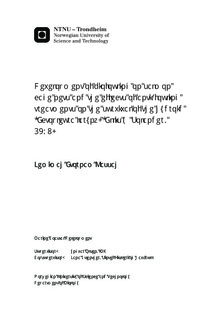Development of biofouling on salmon cage nets and the effects of anti-fouling treatments on the survival of the hydroid (Ectopleura larynx) (Ellis & Solander, 1786)
Master thesis
Permanent lenke
http://hdl.handle.net/11250/245054Utgivelsesdato
2012Metadata
Vis full innførselSamlinger
- Institutt for biologi [2575]
Sammendrag
Biofouling has become a serious problem for farmers in the Norwegian finfish aquaculture industry in recent years; with the hydroid Ectopleura larynx dominating the fouling community in southwestern and mid-Norwegian waters. Most farmers in Norway use a combination of strategies to deal with fouling: the use of copper coated nets combined with washing, the use of copper coated nets combined with drying, and the use of uncoated nets combined with frequent washing. Concerns have been raised about the use of copper coatings on nets due to possible environmental threats. A better understanding of fouling patterns with depth and time; as well as the effectiveness of environmentally friendly treatments is needed. The aims of the study were to identify the temporal and depth variability of biofouling on salmon cage nets from a farm in mid-Norway. Additionally, the effect of drying on hydroid survival and the effects of environmentally friendly anti-fouling treatments on the survival of E. larynx were investigated. The first experiment was to look at the development of biofouling on salmon cage nets at 3 different depths (1, 5 and 10 m) over a six month period (June-November). The second experiment involved the drying of hydroid colonies at 6 different drying times to determine the shortest time needed to ensure complete mortality of hydroids. The third experiment was to determine the effects of washing and drying on the recovery of hydroid colonies, using 5 different treatments; after which hydroids were allowed to recover for a two week period and analysed. The results showed that the major fouling groups were algae, molluscs, hydroids, crustaceans and bryozoans, with hydroids becoming abundant from August onwards. Hydroids began to completely colonise the nets from 10 m in September and then completely colonized the nets at all three depths in October and November. 48 hours of air drying caused a complete mortality of hydroids. Dead hydroids shed their hydranths and cut or damaged hydroids were capable of regeneration. Nets which had hydroids removed, damaged or cut by the washing process had the highest percentage growth increase after a two week recovery period. This study demonstrated that fouling communities differ with depth and time but are driven by some ecological interactions, and that, a combination of washing and then killing of hydroids with hot water; or washing and then drying can help farmers deal effectively with fouling. Further research into the feasibility of these on an industrial scale is recommended.
